By the winter period, any private house must be warm up well. Obviously, in the cool seasons, the dwelling is blown by the ice wind from all sides. Most often it turns out that in situations where the house has no insulation, even special heating equipment helps. Specialists argue that heaters can only be used in addition to high-quality warming.
If we talk about current trends, then manufacturers can offer almost a wide variety of insulation of the house. When you go to the construction store, it immediately becomes clear that to choose the insulation material will not be easy. The bad news is that it is incredibly easy to acquire poor products, especially if the buyer has not analyzed the information (including user reviews) from the Internet.
In this article, we will deal with what insulation will acquire for outside walls at home. Moreover, we will try to consider each step of the process of insulation of walls, as well as separately we will tell about the main difficulties that can be encountered in this matter.
First steps on the warming of walls
Despite the fact that there is a huge number of options for the insulation of the outer walls of the housing, only some of them are popular with popularity. We need to choose the most optimal method of insulation, after analyzing all its strengths and weaknesses. However, first, it is necessary to choose the optimal thermal insulation material.
Selection of insulation
- Styrofoam. This is most likely the most common insulating material, which, by the way, does not lose its popularity at all over decades. It is worth admitting that the owners choose this particular material due to its low cost. As for its properties, the foam really has a low thermal conductivity (and this is very important for the insulation), as well as this resource is very easy to mount. If you want to save on the insulation, it definitely should look at the foam, but you do not need to expect a miracle from this product. But it is possible to say exactly that when insulating foam walls in the house there will be a fairly comfortable temperature.
- Glasswater. This is another classic building material, however, in contrast to foam, it has increased strength and elasticity. This resource has good thermal insulation properties, but it should be borne in mind that it is not recommended to maintain the newcomers. The thing is that the material consists of a plurality of small particles that can negatively affect human health. Accordingly, it is necessary to follow the safety technique, as well as not to disturb the installation technology.
New insulation
As mentioned, in recent years, there have been many new thermal insulation materials on the shelves of shops. Obviously, almost all this products are distinguished by excellent properties, allowing you to warm up almost any construction. Experts argue that almost all new insulation are improved variants of classical products. It should be noted that this applies far from all products, so you need to choose responsibly.
- Polyurethan. This material is one of the varieties of foam. This resource is supplied in liquid form, but after applying gradually hardens and provides excellent thermal insulation properties. Of course, the effectiveness of this insulation is based on high-quality adhesion with a wall. In addition, due to the original method of applying a resource, we lose the seams and gaps that are often the cause of low thermal insulation properties. But at the same time it should be borne in mind that Poly Penopletretan is not the cheapest pleasure, and if the home is large, it will take a lot of material.
- Extruded polystyrene foam. This is another dense thermal insulation material that has a lot of positive sides. Experts assure that this type of polystyrene is distinguished by low thermal conductivity, high frost resistance and practically absence of water absorption. All specified properties are the most basic when choosing an insulating material, especially for external insulation. Again, you should not forget about the price issue, since the material is actually not cheap. If the structure has modest dimensions, then the owners are often not saved on such things. In other cases, savings unequivocally makes sense.
- Mineral wool. This insulation resource can also be called rare. It is used in a wide variety of conditions, so you can talk about the universality of mineral wool. This is a fibrous material, and it has a lot of common with glass. However, the main advantage of minvati concerns complete safety during installation work, since the resource consists of metallurgical slags, and not from the waste of the glass industry.
- Basalt wool. From the title, it can be understood that a basalt breed is used in the material, which is quite good thermal insulation. Manufacturers often boast that basalt material is able to serve the owners for 40 years, and the insulation will not lose its basic properties. For some types of buildings, this advantage is of great importance. The cost of the material can fluctuate.
Properties of insulation
As for the main properties of the material, you should pay attention to some important factors. First of all, experts recommend paying attention to the density of the resource. The more dense material, the better it will hold heat. Almost all materials have an excellent density, and it definitely pleases. The remaining properties of thermal insulation:
- Water absorption. Of course, for external insulation, this factor is incredibly important. If the material absorbs moisture, he will immediately begin rapidly lose its most important properties. In a short period of time, the insulation will become useless, so you need to choose a material with a low water absorption coefficient. In addition, it is necessary to reduce the likelihood of water from the insulating material, for this purpose, various finishing and waterproofing materials are used.
- Thermal conductivity. As we have said, it depends on this property, the insulating material will cope with their immediate tasks. The lower the coefficient of thermal conductivity, the more heat will keep the material. Almost all insulation have low thermal conductivity, however, some modern material in this regard should be treated very seriously.
- Furnishing and environmental friendliness. The safety of using insulating material is an equally important issue to which it is necessary to relate to. Unfortunately, you can find dozens of insulating materials that are easy to ignite. For outdoor insulation of walls, this is not the best option, since the whole house may be under the threat of fire. As for the environmental component, this is also the most important question, which primarily relates to residential premises. Internal insulation, if it has some toxicity, may be extremely negatively affecting the health of residents. For external insulation, it is also better to use similar materials. Toxic insulation is often used in warehouses and in industrial premises, where people move quite short.
Preparation of walls for insulation
Immediately after we have chosen insulating material, the preparation of walls should be prepared for the insulation mounting.
- First of all, the old layer of plaster is removed. If there is an old insulation on the wall surface, it should also be deleted. Accordingly, all finishing materials are dismantled.
- After that, the surface is primer. For this wall should be smooth (brickwork, wooden walls or concrete slabs). In the event that there is a significant deepening of the wall (about 2 cm or more), it is necessary to correct the situation with the help of a cement solution. As for the primer, the pre-wall need to be cleaned from dirt and dust so that the result of the repair work is as high as possible.
- Before starting the process of installing the insulation, you need to install the plumbing and lighthouses in advance. Thus, we will define the plane of the exterior edge of the insulation, and this, in turn, will facilitate installation. With the help of anchors and screws, a durable thread is tested, which falls to the bottom of the nose. Approximately the garter and horizontal threads occur, which makes it possible to fully determine the arrangement of the insulating material.
Creating a crate
It should be borne in mind that now the builders use a large number of wall insulation options. We are talking about the location of materials, the number of layers, as well as installation density. Again, it all depends directly from the specific structure and the existing situation in general. For example, in places where in the winter the temperature drops to -30 degrees Celsius, it is still advisable to use two layers of insulation. As for the use of rolled insulation, there is no need for the creation of the crate.
If there is a need to create really high-quality insulation, it is better to use a slab option of insulating products.
The neckenet may directly consist of a wide variety of materials, but the following construction resources are most often used:
- wood;
- metal;
- plastic.
Obviously, the metal case will be distinguished by high quality and durability, a wooden lamp, at the same time, has little weight and practicality, but it is impossible to exclude that after a while wood can lose its primary properties and cause the deformation of the entire insulating structure.
Plastic is also a good option to create a crate, especially pleased that such a frame is not amenable to corrosion.
- First of all, before creating a crate, you should consider a step. This distance should be equal to the width of the insulating material. But at the same time it should be done so that the insulation material is very tightly consisted between elements of the structure. The width of the elements of the crate should be equal to the thickness of the insulation.
- Fastening the elements of the crate occurs with the help of self-tapping and dowels. It should be borne in mind that it is necessary to mount the design as much as possible and really reliably, so that under the weight of the insulation, insulation does not start to deform and can't collapse.
Installation of insulation
- In the event that we use the rolled insulating material of a small thickness, then it may be enough for the most common installation of wood planks over the insulation. Again, everything should be kept tight so that the cool air could not penetrate the dwelling.
- If the slab insulation is tightly placed between the elements of the crate, then the additional attachment can not be used. However, it should be confident that after finishing works, the insulating material will not begin to deform and spoil the appearance of the structure.
- Most often, the so-called fungus is used to strengthen the plates - a fastening element that has a large hat, with which the material will always remain in one place. Such a fastening is often used for glass wool, mineral wool.
As for the choice between the horizontal and vertical frame of the crate, the principal difference is not here. Of course, the vertical crate to create is significantly easier, especially if the insulation has a greater thickness.
If you plan to create two layers of insulation, for each of them is a separate crate.
Already after installing the insulation, a layer based on cement and reinforcement is created, after which it makes sense to use the facade plaster. If done correctly, the exterior of the house is very attractive.

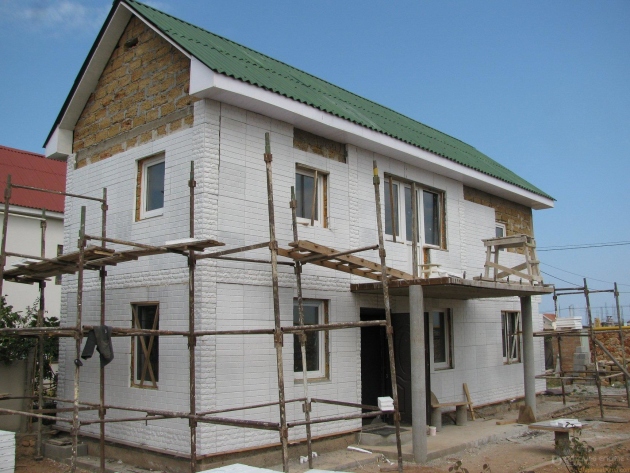

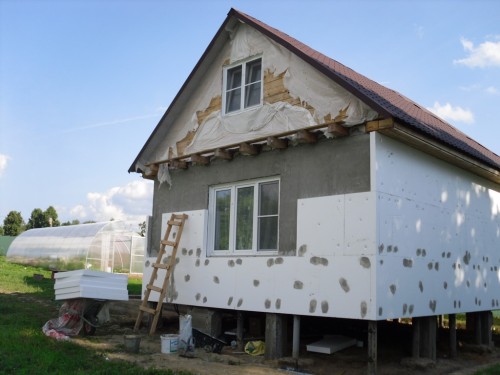
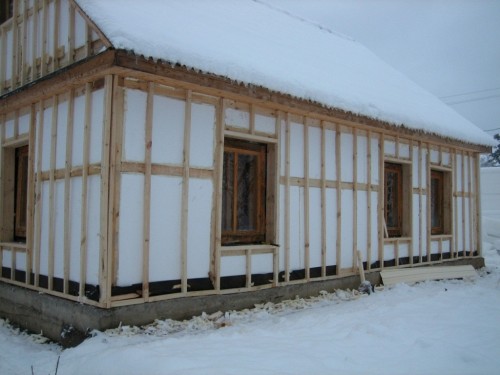
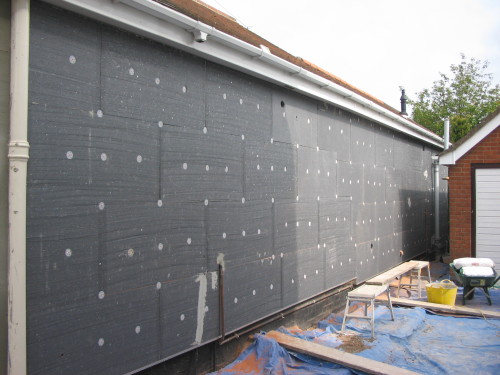










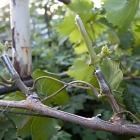

 Start a discussion ...
Start a discussion ...